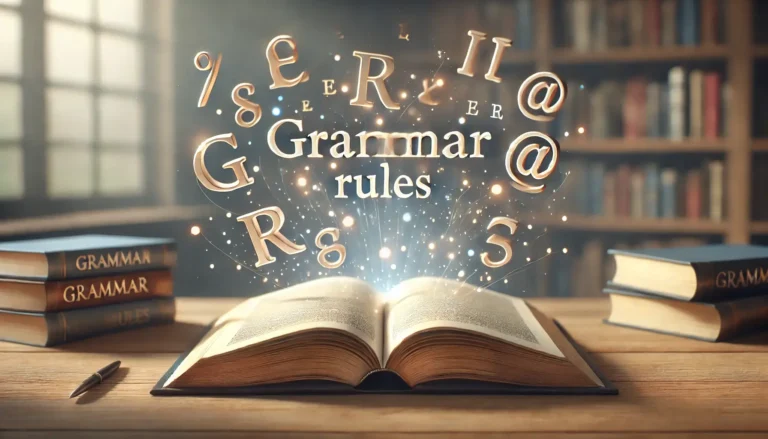Adjectives are powerful tools that make language more expressive and colourful. Imagine reading a sentence without adjectives—everything would feel flat!
For example, instead of saying, “The beautiful sunset painted the sky in soft shades of pink and orange,” you’d be left with, “The sunset painted the sky.” Adjectives bring scenes, descriptions, and emotions to life.
In this blog, we’ll dive into what adjectives are, the different types you can use, and how to structure them in sentences. You’ll also learn how to use them efficiently, with plenty of examples to illustrate each point.
What Is an Adjective?
An adjective is a word used to describe a noun or pronoun, giving additional information about qualities such as size, color, shape, or emotion.
Adjectives often answer questions like: What kind? Which one? How many? How much?
Examples:
- The sky is blue.
(What color is the sky? The adjective “blue” describes the color of the sky.) - She wore a long dress.
(How long is the dress? The adjective “long” describes the length of the dress.) - There are three cats in the garden.
(How many cats are in the garden? The adjective “three” describes the number.)
Illustration:
Consider a scene without adjectives:
- I see a dog.
Now, add adjectives: - I see a small, fluffy, brown dog.
The adjectives “small,” “fluffy,” and “brown” give a clearer picture of the dog.
Types of Adjectives
There are various types of adjectives, each serving a unique role in describing or specifying nouns.
Descriptive Adjectives
These are the most common type of adjectives, providing details about the qualities of a noun.
Examples:
- The spicy food made my mouth burn.
(The adjective “spicy” describes the taste of the food.) - The beautiful painting caught everyone’s attention.
Illustration:
- Without adjective: I saw a painting.
- With adjective: I saw a beautiful, colorful, intricate painting.
Quantitative Adjectives
These provide information about the quantity or number of a noun.
Examples:
- He ate some cookies.
(How many cookies? “Some” gives an approximate number.) - She has four books.
Illustration:
- Without adjective: She has books.
- With adjective: She has many books.
Demonstrative Adjectives
These point out specific nouns and include this, that, these, and those.
Examples:
- I want that pen.
- Can you pass me these papers?
Illustration:
- Without adjective: Can you pass me papers?
- With adjective: Can you pass me these important papers?
Possessive Adjectives
These show ownership and include words like my, your, his, her, our, and their.
Examples:
- That’s my car.
(The adjective “my” shows ownership of the car.) - We need to clean our house.
Interrogative Adjectives
These are used in questions and include which and what.
Examples:
- Which cake do you prefer?
- What time is the meeting?
Illustration:
- Without adjective: Cake do you prefer?
- With adjective: Which cake do you prefer, the chocolate one or the vanilla one?
Distributive Adjectives
These refer to individual members of a group and include each, every, either, and neither.
Examples:
- Each student must submit their work.
- Neither option seems appealing.
Proper Adjectives
These are derived from proper nouns, usually indicating nationality or brand.
Examples:
- We visited the Chinese restaurant.
- He loves Italian fashion.
Illustration:
- Without adjective: We visited the restaurant.
- With adjective: We visited the famous Italian restaurant.
Order of Adjectives
Order of Adjectives
When using multiple adjectives in a sentence, they typically follow a specific order. Here’s the general order:
Quantity/Number
- Example: Three chairs
Opinion
- Example: Beautiful flowers
Size
- Example: Large building
Age
- Example: Old book
Shape
- Example: Round table
Color
- Example: Red car
Origin/Nationality
- Example: Mexican cuisine
Material
- Example: Wooden door
Purpose
- Example: Sleeping bag
Example Sentence:
- I bought two large round red wooden Italian tables.
Illustration:
Without adjectives:
- I bought tables.
ujgkhkoll
With adjectives:
- I bought two beautiful large antique round mahogany dining tables.
Multifunctional Adjectives
Some adjectives serve multiple purposes, acting as both adjectives and other parts of speech. A common example is “fast,” which can be an adjective or an adverb depending on its usage.
Examples:
- Adjective: He has a fast car. (Describes the noun “car”)
- Adverb: He drives fast. (Describes the verb “drives”)
Illustration:
- Fast as an adjective: The cheetah is fast.
- Fast as an adverb: The cheetah runs fast.
Another example is “hard”:
- Hard as an adjective: That is a hard rock.
- Hard as an adverb: She works hard.
Adjectives in Sentences
Adjectives can be placed in different positions in a sentence, either before the noun or after a linking verb.
Before a Noun
- She has a small dog.
- I enjoy sunny days.
After a Linking Verb
- The sky is blue.
- They seem happy.
Illustration:
Without adjective:
- The house is.
With adjective: - The house is beautiful.
Adjectives can also be used in comparative and superlative forms:
- Comparative: He is taller than me.
(Used to compare two things) - Superlative: She is the smartest in the class.
(Used to compare three or more things)
Learn about the comparative and superlative forms here.
Summary
Adjectives are key to making language more descriptive and vivid. They can describe color, size, shape, and more, while also allowing us to compare things or ask questions about them.
By understanding the different types of adjectives, how to order them, and how to use them in sentences, you can add clarity and richness to your communication. With practice, adjectives will become an essential part of your writing and speaking toolkit.
Now, go ahead and experiment with adjectives in your everyday language!







